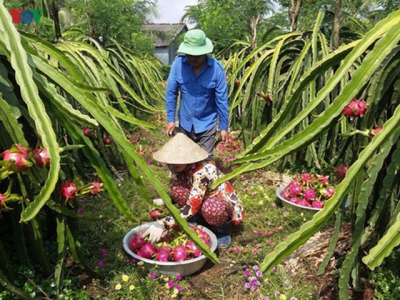Seminar highlights intl linkages to improve competitiveness of dragon fruit

A seminar was held in the Mekong Delta province of Tien Giang on September 9 with the purpose of finding ways to increase the competitiveness of dragon fruit products and expand into new export markets.
The event, co-hosted by the Vietnam Academy of Agricultural Sciences and the Food and Fertilizer Technology Center for the Asian and Pacific region, drew close to 100 participants ranging from speakers, scientists, managers, manufactures, and business representatives from 11 countries from across the Asia Pacific region.
Currently, dragon fruit trees are grown in 20 countries and territories worldwide, and are mainly focused in the Asia Pacific region, including nations such as Vietnam, Thailand, Indonesia, the Philippines, China, Taiwan, and Australia.
In Vietnam, the dragon fruit cultivation area and output rank first throughout Asia with roughly 49,000 hectares and an annual output of over one million tons.
Most notably, domestic dragon fruit is exported to 40 nations and territories globally, of which the Chinese market makes up 80 per cent.
Last year, the export of dragon fruit raked in over US$1.1 billion, accounting for over 50 per cent of the country’s total export value of fresh fruit. In a boost to the fruit product, the item has recently entered demanding markets such as the Republic of Korea, Australia, EU, the United States, and Japan.
The seminar participants pointed out that local dragon fruit faced a number of shortcomings including harmful pests, diseases, improper farming techniques, chemical residues, as well as limitations found during the postharvest, preservation, and processing processes.
In addition, dragon fruit farmers have yet to apply Good Agricultural Practice (GAP) standards used during the production procedures, while there remains limitations in strengthening linkages to build the value chain for dragon fruit.
They shared their experience and devised strategies to support small households in complying with the quality management system, quarantine regulations, and improving the overall quality of dragon fruit in order meet the import demand of foreign nations.
There should be greater co-operation during research activities among members of the dragon fruit network within the Asian Pacific region in order to boost the development of dragon fruit trees in the future, they said.
Có thể bạn quan tâm
 US cherries, lobster best-sellers in Vietnam
US cherries, lobster best-sellers in Vietnam Economists attribute the increase in US imports to lower prices and US-China trade tension that have forced US exporters to seek other markets instead of China.
 Global glut pushes down Vietnam’s coffee export earnings
Global glut pushes down Vietnam’s coffee export earnings Since early this year, coffee prices have dropped in both foreign and domestic markets, and no significant change is forecast as the world’s leading coffee
 Ministry helps firms expand farm produce export markets
Ministry helps firms expand farm produce export markets Continuing to work with other ministries, sectors and business associations to help Vietnamese businesses expand farm produce exports.